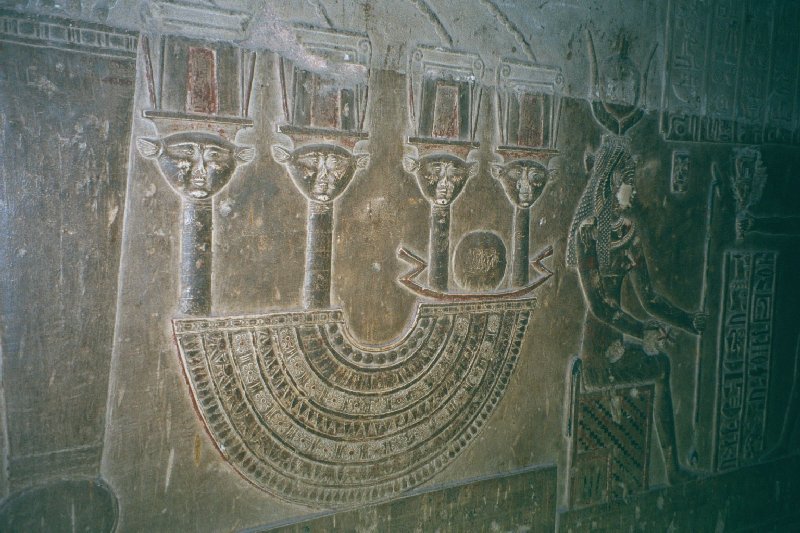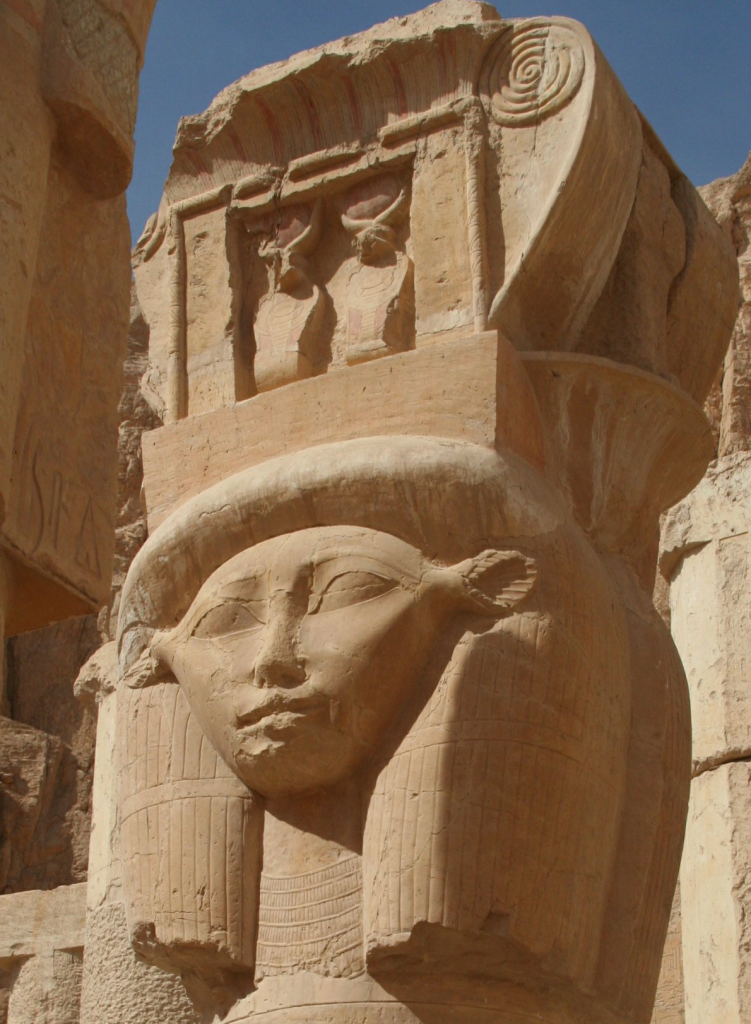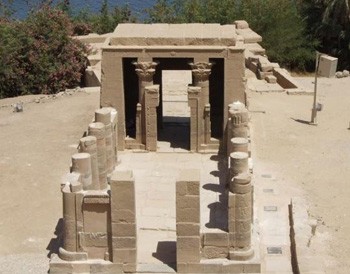On the island of Philae, east of the Temple of Isis, stands a smaller temple to Hathor. The Hathor temple was restored, at least in part, in 2012 and reopened to the public. (Both the Isis and Hathor temples, as well as the other temples of ancient Philae are now on the Egyptian island of Agilkia, aka Agilika, where they were moved prior to the building of the Aswan Dam, which created Lake Nasser and flooded Philae.)
Compared to the Temple of Isis on Agilkia, the Temple of Hathor is quite small. Reciprocally and interestingly, at Denderah, Hathor’s great Ptolemaic temple complex, there is a similar small Temple of Isis. Clearly, there is a relationship between these two Great Goddesses; so much so that it was required that each Goddess would have a smaller temple near the great temple of the other.
In fact, sometimes that relationship between Isis and Hathor is so close that it’s hard to tell Them apart. Beginning in the New Kingdom, we regularly see Isis wearing the Horns & Disk crown of a Cow Goddess that is emblematic of Hathor. Sometimes Isis also has a small throne on top of the Horns & Disk to indicate that She is indeed Isis rather than Hathor, sometimes She doesn’t. But guess what? Hathor sometimes borrows Isis’ headdress, too.
Again at Denderah, we find a carving of Hathor—and the hieroglyphs confirm that She IS Hathor—wearing the Horns & Disk with the throne on top. It’s a bit hard to make out in this photo, but you can see the throne sitting atop the disk in Hathor’s crown.

Both Isis and Hathor are associated with Horus, Isis as His mother, Hathor sometimes as mother, sometimes as lover. Both are Cow Goddesses and Goddesses of the Sycamore, though Hathor probably has the prior claim on both these symbols. Both are Eyes of the Divine and holy Uraeus Serpents, powerful, fiery, protective and vengeful Goddesses. Thus both can become Sekhmet, that most fierce and bloodthirsty of Goddesses. Both Isis and Hathor are Goddesses of the Otherworld, Goddesses of rebirth and resurrection, Whom the dead ones adore.
Looking just as these correspondences, Isis and Hathor seem interchangeable. Is it so?
I don’t think so. Instead, They are sister branches of the Divine Tree. They are ultimately united in the Tree’s trunk, yet there is a quite palpable difference in the energy feeling of the two Goddesses—at least out in the twigs and leaves of the Tree where we most often experience Them. As you know, I have an enduring dedication to Isis, but in another part of my spiritual life, I also have a strong connection to Hathor.

Hathor’s energy always has an underlying feeling of excitation, of arousal. It may be sexual, but it doesn’t have to be. Hathor imparts the excitement of living, and thus She is the Great Lady of Love, Joy, Drunkenness, and Dance. Her symbol par excellance is the sistrum, the sacred rattle that is shaken to stir things up. In Egyptian, to “play the sistrum” is iri sekhem, to “do power.” Hathor has something of the maenad in Her, if I may draw from a different cultural metaphor; She’s a bit more wild than Isis, more likely to roar or hiss or spit. O, but She will dance you to ecstasy; She will love you to ecstasy; She will sing you to ecstasy. Perhaps She will also put a bit of Divine terror into your belly while She’s doing it. But then She will turn Those Eyes upon you, those soft, bright, deep cow’s eyes, and She will soothe you, take you in, and make you understand that Love, only Love, is at the heart of the Divine reality.
Of course, Isis, too, inspires passion. She certainly inspires it in me. But that’s not the foundation of Her energy. At Isis’ heart is strength interwoven with the numinous power of magic. Hathor’s tingle is the excitement of life and love. Isis’ tingle is the excitement of magic, of heka. Hers is a deep, sometimes overwhelming, Intelligence; flowering in my mind like stars that blossom into the depths of Space and Time.

And yet, and yet. The Mystery of these two Great Goddesses is such that They can share many or even most of Their symbols, and have a share in each other’s power.
Blessed be the Ladies.


YESsssss sššt sššt sššt sššt
Shimmering Systrum Blessings
PS with your permission I would like to repost this at my blog:
Opps I accidentally hit the return button thus submitting this before giving you the link to my blog:
https://hathorsystrum.blogspot.com/
That would be lovely!
OK! sššt sššt sššt sššt
Of course, please and thank you!
Alright, I love that description of Hathor. Would it be appropriate to say she’s similar to Lakshmi?
Also: if ISIS IS ALL THINGS AND ALL THINGS ARE ISIS, how is it that Hathor and Isis aren’t really one and the same? Or is that like comparing Parvati and Lakshmi, but then acknowledging they are both faces of Shakti?
Ah, I don’t really know Lakshmi, so I can’t say on that. What do you think?
After thinking and refreshing my memory with the book Awakening Shakti, I guess I would say yes!
Happy Full Moon of October! I love your writings about Isis! Hathor is one of my chosen Goddesses … or rather, SHE chose ME. Blessings on this moon-lit morning!
You, too!
I think you’re right about those two: Hathor is more about the joy of life, while Isis is about the mastery of magic.
Thank you so much for this explanation of the energetic differences between Hathor and Isis. It was most clarifying. Am wondering if anyone could recommend a Hathor priestess training? I am a dancer and have vowed to worship Hathor, but have been doing so primarily on my own. Any advice?
A dancer! Wonderful. Sounds perfect for Her. I’m afraid I’m not aware of any Hathor-specific training. But there is plenty in Isis Magic that can be adapted to Hathor…with the addition of a lot more dancing, of course. You can find courses out on the internet. But I don’t know the folks involved, so can’t really help there. Many blessings on your path with The Golden One.
Greetings Charlotte,
I invite you to visit the website: http://www.HathorSystrum.com
MORE: After travels to Egypt in 2007, I returned home to the United States with the inspiration to hold a sistrum and to shimmer an instrument akin to what was carved on the temple walls! However, what I saw was not represented in the “marketplace” ~ only on museum shelves. Thus began a quest to re-emerge an easy-to-play percussion instrument to invoke the presence of the Divine into one’s home, studio, life. It took many years and collaborating with various friends along the way to convincing a manufacturer to follow my design specs and now we are happy to say all this effort resulted in the beautiful and wonderful Ceremonial Systrum™ created as the result of this dancing priestess’s quest to design/create and re-emerge the instrument she saw carved on the ancient Egyptian temple walls to add to her collection of frame drums, finger cymbals and singing bowls.
It has been a magical journey and along the way I was blessed to make acquaintance with Naomi Ozaniec who penned a fabulous resource delving deep into understanding Hathor “Becoming Hathor.” (For more details, please go go: https://www.hathorsystrum.com/about-the-systrum/becoming-hathor )
In addition Naomi wrote some exquisite guided visualizations which she invited me to record (and I did! ~ Read more here: https://www.hathorsystrum.com/order-online/journey-with-hathor-detail )
Last but not least I imagine as a devotee of Hathor, you will want a Ceremonial Systrum™ (read more here: https://www.hathorsystrum.com/about-the-systrum )
May Hathor, Mistress of Music,
Lady of the Systrum
bring melody, harmony, peace & love
into your life and sing your praises!
sššt sššt sššt sššt
Shimmering Systrum Blessings
—
Tahya | Dancer, Drummer, Designer of the Ceremonial Systrum™
http://www.Tahya.com
http://www.HathorSystrum.com
Still not competent to enter the discussion meaningfully, but I appreciated this.
The dichotomy of the ladies makes me think of the Freyja/Frigga dynamic in Nordic systems.
Frigga was the queen of arcane arts, equivalent to Odin in his lordly capacity.
Freyja was the lady of ecstasy, equivalent to Odin in his wandering form.
They are held to be one goddess, aspects of a whole. As Freyja is marred to Od, whom she mourns when he wanders. Frigga, meanwhile, rejoices when he returns.
Anyway. Freyja wanders and enjoys carnal things, whereas Frigga stays at home and is wise, leaving Asgard once on record to secure oaths from nature that her son would come to no harm. Later baldur (light god) was slain by hodur (dark god.) Frigga dispatched Odin to the underworld, and Odin sent Skirnir, but Baldur would have to wait till Ragnarøk to live again.
For context, I guess.